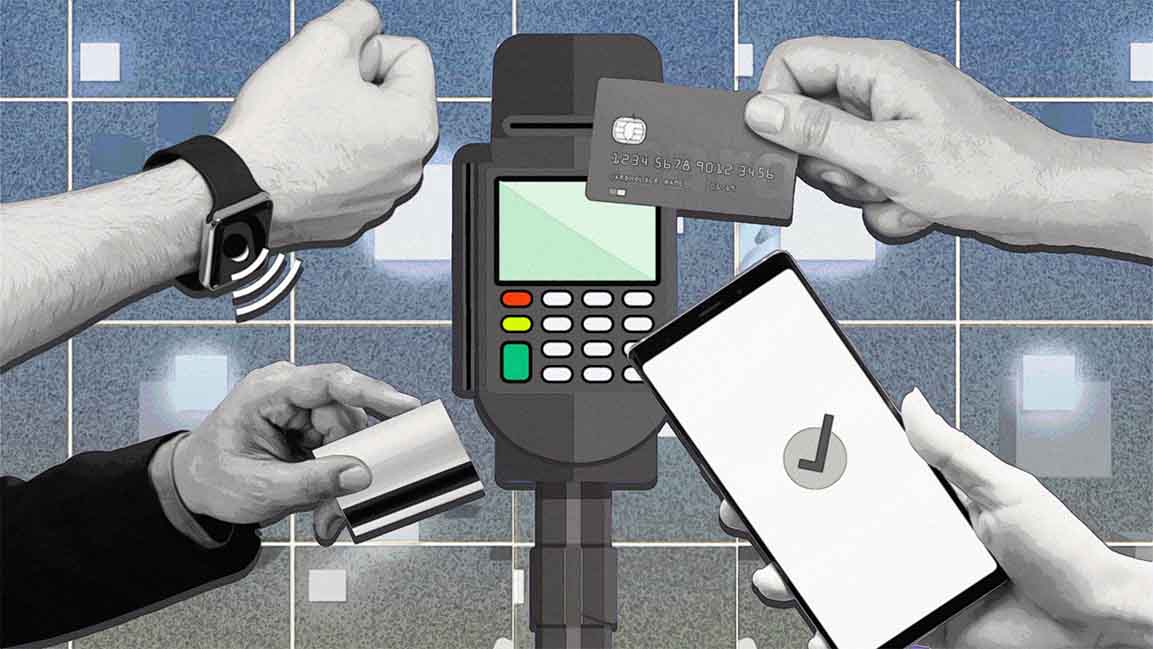- | 9:00 am
Is the MENA region ready to be a cashless society?
Though there are significant advantages of non-cash payments, physical currency will continue to exist for now, say experts

Do you tap, wave, insert, or hold out for cash? If you are still patting pockets or rummaging in purses than swiping or clicking, you’re fast becoming an exception. Fast-tracked by the pandemic, a growing enthusiasm for online shopping, the ease and speed with which we can now make payments, and the advent of digital wallets, more and more of us are shunning physical money.
Although this is a relatively recent trend, the shift has been rapid in the Middle East and North Africa (MENA) region. A growing number of businesses, both big and small, now refuse cash, with many having opted to go card-only over the past couple of years.
According to a report from the MENA Fintech Association, seven out of ten transactions will be cashless in 2023. A Mastercard survey found two-thirds of consumers in the region would like to try alternative payment methods and will avoid companies that don’t offer a cashless option.
“Mirroring global trends, the MENA region is steadily progressing towards a cashless society,” says Abdulla Almoayed, Founder and CEO of Tarabut Gateway.
The big advantages of non-cash payments are that they are seamless, efficient, and convenient. This matters a lot to consumers.
It is also a means of promoting financial inclusion, and the rapid growth of the mobile payments industry presents business opportunities to capitalize on.
“Saudi Arabia and UAE are now clocking 50% of transactions through digital methods such as cards, digital wallets, instant payments, etc.,” says Piyush Dubey, Partner at Kearney Middle East and Africa Financial Institutions Practice.
“Digital payments are now a part of the lifestyle. Even merchants, including small grocery stores, are embracing acceptance of digital payments.”
Agreeing with Dubey, Khalil Alami, Founder and CEO of Telr, a payment gateway provider, says, “Paying through smartphones has become the new norm, particularly among the younger generation, and very soon, they will become the standard mode of payment.”
Alami says the rise of digital payments suggests a fundamental shift in the economy, fueling innovation, disrupting traditional models, and creating new avenues for generating revenue. “With new payment gateways to facilitate easy digital payments comes with new potential jobs that will contribute to the economy.”
Going digital can bring substantial cost savings for merchants and businesses alike, says Manav Mehra, Chief Product and Design Officer – Processing, Network International, “by reducing the complexity of their cash management procedures as well as the risk of misappropriation.”
On a larger scale, he adds, the wealth of data created from digital payments enables governments to create more reliable economic forecasts, allowing for more effective policy settings.
WHAT’S LEADING THE TRANSFORMATION?
Crucial to this transformation are open banking and other digital payment methods, such as digital wallets and cryptocurrencies, and a surge in e-commerce.
“Licenses of new payment operators and changing consumer behavior are also driving the shift towards cashless payments in the region,” says Nidal Khalifeh, Chief Innovation Officer, Jordan Ahli Bank.
Competition is growing from key players in the financial industry within GCC markets. Digital wallets and payment solutions are capturing the market with innovative product offerings and solutions. “Big tech companies have entered the markets and consolidated their position in recent years. For example, Apple Pay’s tokenized offerings are now widely used,” says Dubey.
Almoayed says the transition to a cashless society is a key pillar in many long-term national strategies. “This clear endorsement of digital payment methods underscores the region’s commitment to embracing the future of finance.”
EXPERIMENTING WITH CBDC
Central bank digital currencies, or CBDCs, are gaining popularity, with 109 countries actively exploring or engaging with them across various phases of development.
In the region, a few central banks are experimenting with CBDCs to keep their money relevant. These currencies are virtual, issued by the state, and function like traditional currencies. The idea is for central banks to introduce these digital currencies in limited circulation and broaden their circulation over time as they gain popularity and cash fades away.
The UAE Central Bank (CBUAE) has launched its digital currency implementation strategy, which forms one of the key initiatives in its program to digitize the country’s finance sector. The CBUAE said a CBDC would eventually be applied across various domestic and cross-border use cases in the region.
The Saudi Central Bank (SAMA) is also experimenting with adopting a CBDC to support the kingdom’s digital economy and fintech market growth. SAMA’s interest in CBDCs runs deep as the bank ran a collaborative study with the UAE’s central bank, Project Aber, in 2019. At the end of the study, both central banks agreed on the viability of a CBDC with cross-border functionality for Gulf countries.
“With appropriate design and seamless integration, CBDCs could complement platforms like mobile wallets, digital payment applications, and online payment gateways. Their integration holds an enticing value proposition: streamlining transactions and reducing costs, leading to a more efficient banking and payments landscape,” says Almoayed.
To design a CBDC for use across different payment platforms, Mehra says several factors need to be considered. “Firstly, interoperability is crucial. It should be compatible with existing payment infrastructure, and this requires collaboration between the central bank, commercial banks, and other financial institutions to ensure seamless integration and interoperability.”
Payments made using CBDCs will grow from $100 million this year to $200 billion in 2030, revealed a recent Juniper research. It is a 260,000% increase over the next seven years.
“Around 114 countries, representing over 95% of global GDP, are currently exploring a CBDC solution with 11 countries having fully launched a digital currency,” says Dubey.
Recently the International Monetary Fund (IMF) announced it is working on a platform for CDBCs to enable transactions between countries.
“CBDCs should not be fragmented national propositions… To have more efficient and fairer transactions, we need systems that connect countries: we need interoperability,” IMF Managing Director Kristalina Georgieva told a conference attended by African central banks in Rabat, Morocco, adding that the IMF is working on the concept of a global CBDC platform.
The IMF wants central banks to agree on a common regulatory framework for digital currencies that will allow global interoperability.
“CBDCs will enhance efficiency and speed in cross-border payments, reduce costs, increase financial inclusion, and promote innovation,” says Khalifeh. “But it requires alignment of different legal and regulatory frameworks, ensuring data protection and privacy, maintaining security and resilience, and balancing centralization and decentralization.”
Further, CBDCs enable money to become programmable, which means they can be designed to have certain features like expiry dates, transaction limits, and smart contract functionality. “CBDCs can increase financial inclusion by providing access to digital payments for individuals and businesses that do not have access to traditional banking services,” says Dubey.
CBDCs will not wholly replace digital payment methods. “The future entails integration and interoperability with existing digital payment methods to deliver even greater value to the economy and society,” he adds.
NEXT CYCLE OF INNOVATION
It all started in the late 1990s when PayPal brought online payments to the masses, followed by other players building professional payment tools for merchants. Now, we are in the mid stages of the next cycle of payment innovation. Investment in financial technology is at an all-time high. Unexpected players are entering the market, delivering better customer experiences faster and cheaper.
“The emergence of new players in the market created a competitive space against the traditional banking infrastructure, sparking a wave of innovative payment solutions,” says Almoayed. “This wave of innovation, led by both fintech firms and banks, yielded consumer benefits and had a profound, positive impact on the overall economy.”
Digital payments promote private sector competition and encourage innovations that make electronic payments cheaper, quicker, and more secure.
“Payment fintech comprises the highest % among regulatory sandboxes across GCC countries,” says Dubey. “Digital wallets and payments solutions are capturing the market with innovative product offerings and solutions. Introducing new payment technologies provides options to end users and merchants, further contributing to growth in digital payments.”
Additionally, payments serve as logical stepping stones towards integrating with other lifestyle needs of individuals. Several private sector entities are eying “super-app” opportunities in the region, providing payments and non-payment offerings like ride-hailing, food orders, marketplace, loyalty, and rewards.
“The battle is fierce amongst the private sector to tap into the exponentially growing digital payments landscape, presenting commercially advantageous opportunities,” adds Dubey.
But with the mass adoption of digital payments, private companies spearheading fintech’s move for the future are only going to expand, says Alami. “While companies are racing to adopt the digital payments in their services and integrating it as a crucial part of the customer journey to ease operations and increase customer loyalty.”However, as the digital payments landscape becomes increasingly complex, ensuring interoperability and standardization among different platforms and systems remains an ongoing challenge. “Fragmentation and lack of integration can impede competition and innovation, hindering the full potential of digital payments,” says Mehra.
WILL CASH BECOME OBSOLETE?
Undoubtedly, non-cash has far-reaching effects on the economy, finance, and society. But Khalifeh says cash will not be obsolete in the Middle East anytime soon, but it will “become less dominant as digital payments gain more popularity and acceptance.”
With all the advancements in digital payments, the Middle East is poised to see 70-80% of transactions through digital payments by 2030. “Physical currency will continue to exist as a payment method however will be much less popular,” says Dubey.
In the UAE and Saudi Arabia, non-cash transactions are growing faster; when compared to Oman, Qatar, Egypt, and Jordan, which are yet to see much of a shift away from a cash-based economy.
“There are also some challenges and barriers that prevent cash from becoming obsolete in the region, such as legacy systems and infrastructure of some banks, cash-centric culture and habits of some segments, issues with regulations and compliance arising from cross-border transactions, unclear data protection policies and the fragmentation of the payment market,” says Khalifeh.
Achieving a cashless society requires the active involvement of governments, says Alami. They must lead the cultural mindset transformation and educate people about digital payments’ benefits and security measures. “Governments should collaborate closely with banking institutions, promoting cooperation and reliability to foster a conducive environment for cashless transactions. Ensuring robust security measures is paramount in building trust in digital payment systems.”
Some would argue that a cashless society is the future as retailers and banks have been pushing us to use contactless payments and online services. But taking cues from countries with the highest degree of digital payments transactions, like Nordic countries, 100% cashlessness has yet to be achieved anywhere in the world.
“Cash will continue to coexist with other digital payment methods such as CBDCs, instant payments, card-based payments, and wallet-based payments,” adds Dubey.







































